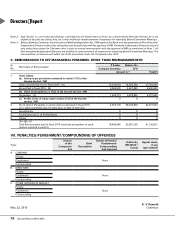ICICI Bank 2015 Annual Report Download - page 82
Download and view the complete annual report
Please find page 82 of the 2015 ICICI Bank annual report below. You can navigate through the pages in the report by either clicking on the pages listed below, or by using the keyword search tool below to find specific information within the annual report.
Business Overview
80 Annual Report 2014-2015
loans and loans for purchasing irrigation equipment, raising cattle and purchasing tractors & other farm equipments. The
Bank also offers financial solutions to commodity traders and processors and to small & medium enterprises engaged in
agriculture-linked businesses operating in rural and semi-urban areas. It also provides loans against warehouse receipt,
loans to Self Help Groups (SHGs) and loans to Micro Finance Institutions (MFIs) for lending to customers. Through its SHG
Bank linkage programme, ICICI Bank caters to over 1.3 million women. The Bank’s employees visit SHGs in their villages
rather than requiring the group to visit the branch. This provides a deeper understanding of the needs of the group in their
local surrounding and each trip saved by SHG members allows them to utilise their time for additional earnings. The Bank
has undertaken a detailed analysis of the customer segments in each micro-market where it operates and has suitably
framed its lending policy in order to mitigate the inherent risks of rural businesses. As a result, the Bank has been able to
maintain the quality of loan portfolio in its rural lending business. In fiscal 2015, the Bank achieved a growth of over 40%
in its direct agriculture lending portfolio under priority sector lending.
Financial inclusion is a national priority and is being pursued by multiple stakeholders including the Government, banks
and non-bank enterprises. ICICI Bank has emerged as a significant player in the financial inclusion space in the country.
Treasury
The treasury operations at ICICI Bank comprises the Proprietary Trading Group, Markets Group and Asset Liability
Management Group.
The Proprietary Trading Group manages investments within risk limits as approved by the investment policy of the Bank.
The Bank is also a leading arranger for debt private placements of bonds/debentures and has dedicated sales coverage of
institutional debt investors across various segments. ICICI Bank continues to be ranked among the top three in the overall
league table rankings for private placement of debt. In fiscal 2014, the Bank arranged the first Basel III Additional Tier 1
bond issue in India by a public sector bank and the first long-term infrastructure bond issued by a bank. The Bank also
continuously engages with regulators, policy makers and industry bodies at various forums for the structural development
of the market.
The Markets Group offers foreign exchange and derivative solutions to clients and continues to be a major player in this
segment. The Bank provides global coverage of markets with a detailed knowledge of local markets. It provides clients with
regular market updates as well as quantitative and qualitative research on topics related to macroeconomics and financial
markets.
The Asset Liability Management Group continued to actively manage the Bank’s liquidity and securities portfolio held for
compliance with statutory and regulatory requirements. The Group focuses on optimisation of yield on the overall portfolio
while maintaining an appropriate portfolio duration given the volatile interest rate environment.
Risk Management
Risk is an integral part of the banking business and the Bank aims at achieving an appropriate trade-off between risk and
returns. Key risks include credit, market, liquidity, operational, legal, compliance and reputation risks. The Bank has in place
an Enterprise Risk Management framework that articulates the risk appetite of the Bank and details the limit framework
for various categories of risk. It also includes the risk governance framework, which ensures oversight & accountability,
continuous monitoring of the environment and an integrated evaluation for effective management of risk.
The Board of Directors has oversight on all the risks assumed by the Bank. The Board has established Committees to
facilitate focused oversight of various risks. These Committees have specific terms of reference. Policies approved from
time to time by the Board of Directors or Committees of the Board constitute the governing framework for each type of
risk. Business activities are undertaken within this policy framework. Independent groups and sub-groups have been
constituted across the Bank to facilitate independent evaluation, monitoring and reporting of various risks. These groups
function independently of the business groups.
Every year, the Risk Committee approves a detailed calendar of reviews. The calendar of reviews include reviews of
risk management policies in relation to various risks, risk profile of the Bank, its overseas banking subsidiaries and key
non-banking subsidiaries, assessment of capital adequacy based on the risk profile of the balance sheet, status with
respect to implementation of advanced approaches under the Basel framework and review of regulatory compliance
issues. The Credit Committee also approves every year a detailed calendar of reviews covering the Bank’s exposure
























